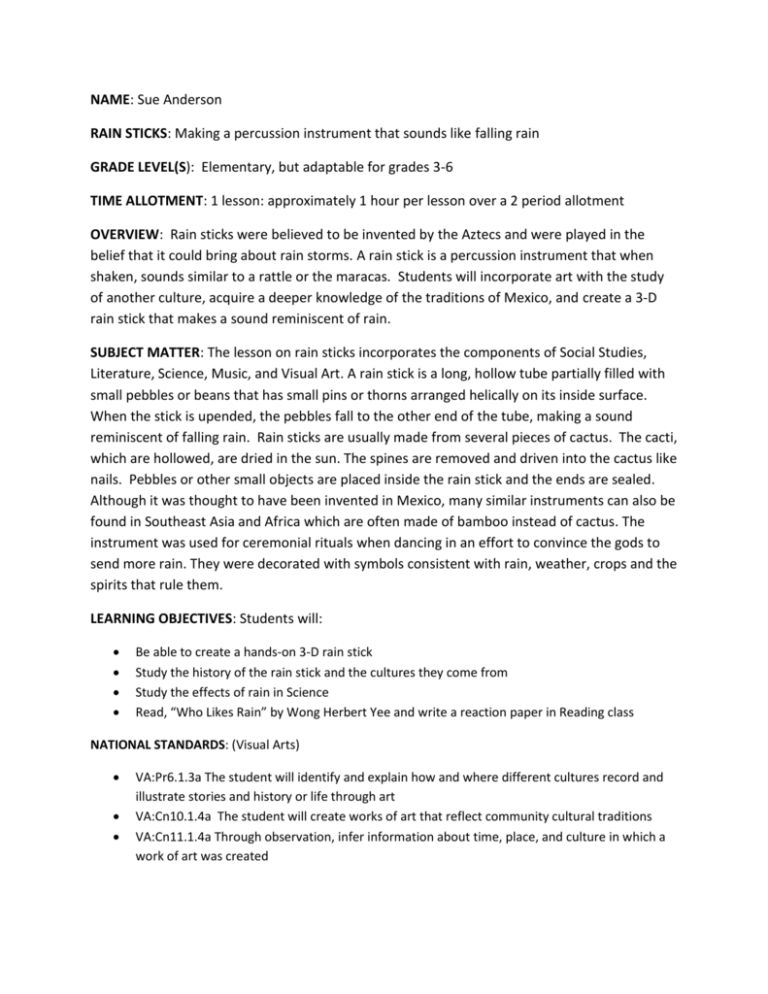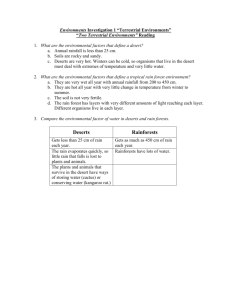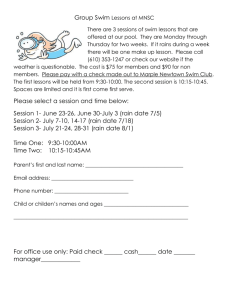Rain Sticks - Prairie Public Broadcasting
advertisement

NAME: Sue Anderson RAIN STICKS: Making a percussion instrument that sounds like falling rain GRADE LEVEL(S): Elementary, but adaptable for grades 3-6 TIME ALLOTMENT: 1 lesson: approximately 1 hour per lesson over a 2 period allotment OVERVIEW: Rain sticks were believed to be invented by the Aztecs and were played in the belief that it could bring about rain storms. A rain stick is a percussion instrument that when shaken, sounds similar to a rattle or the maracas. Students will incorporate art with the study of another culture, acquire a deeper knowledge of the traditions of Mexico, and create a 3-D rain stick that makes a sound reminiscent of rain. SUBJECT MATTER: The lesson on rain sticks incorporates the components of Social Studies, Literature, Science, Music, and Visual Art. A rain stick is a long, hollow tube partially filled with small pebbles or beans that has small pins or thorns arranged helically on its inside surface. When the stick is upended, the pebbles fall to the other end of the tube, making a sound reminiscent of falling rain. Rain sticks are usually made from several pieces of cactus. The cacti, which are hollowed, are dried in the sun. The spines are removed and driven into the cactus like nails. Pebbles or other small objects are placed inside the rain stick and the ends are sealed. Although it was thought to have been invented in Mexico, many similar instruments can also be found in Southeast Asia and Africa which are often made of bamboo instead of cactus. The instrument was used for ceremonial rituals when dancing in an effort to convince the gods to send more rain. They were decorated with symbols consistent with rain, weather, crops and the spirits that rule them. LEARNING OBJECTIVES: Students will: Be able to create a hands-on 3-D rain stick Study the history of the rain stick and the cultures they come from Study the effects of rain in Science Read, “Who Likes Rain” by Wong Herbert Yee and write a reaction paper in Reading class NATIONAL STANDARDS: (Visual Arts) VA:Pr6.1.3a The student will identify and explain how and where different cultures record and illustrate stories and history or life through art VA:Cn10.1.4a The student will create works of art that reflect community cultural traditions VA:Cn11.1.4a Through observation, infer information about time, place, and culture in which a work of art was created VA:Pr4.1.4a The student will analyze how past, present, and emerging technologies have impacted the preservation and presentation of artwork VA:Re.7.1.5a The student will compare one’s own work interpretation of a work of art with the interpretation of others VA:Re.7.1.6a The student will identify and interpret works of art or design that reveal how people live around the world and what they value MINNESOTA STANDARDS: (Visual Arts) (Artistic Foundations, Respond or Critique) VA:0.4.1.5.1 Compare and contrast the characteristics of a variety of works of visual art VA:4.1.1.5.2 Describe how the principles of visual art such as repetition, pattern, emphasis, contrast and balance are used in the creation, presentation or response to visual artworks (Artistic Process, Create or Make) VA:4.2.1.5.1 Create two and three dimensional artworks to express specific artistic ideas (Artistic Foundations, Demonstrate Knowledge) VA:6.1.1.5.1 Analyze how the elements of visual art including color, line, shape, value, form texture and space are used in the creation of, presentation of, or response to visual artworks VA:6.1.2.5.1 Demonstrate the characteristics of the tools, materials and techniques of various two and three dimensional media for intentional effects in original artworks COMMON CORE: (Visual Arts) Anchor Standard #1 Generate and conceptualize artistic ideas and work Anchor Standard #2 Organize and develop artistic ideas and work Anchor Standard #4 Analyze, interpret and select artistic work for presentation Anchor Standard #6 Convey meaning through the presentation of artistic work Anchor Standard # 8 Interpret intent and meaning in artistic work Anchor Standard #9 Apply criteria to evaluate artistic work Anchor Standard #11 Relate artistic ideas and works with societal, cultural and historical context to deepen understanding DIGITAL MEDIA COMPONOENTS – VIDEO AND/OR WEB: -THE RAIN PROJECT – Create a Book About Rain. With a little investigation, children will come to appreciate and learn about rain in new and different ways http://prairiepublic.pbslearningmedia.org/resource/arct14.pre.artproject/rain-project/ -DRAGONFLY TV CACTUS VIDEO – The study of the cactus along with Science http://prairiepublic.pbslearningmedia.org/resource/fd6d153f-d941-49c6-b4cf7e564e51967c/fd6d153f-d941-49c6-b4cf-7e564e51967c/ -THE SCIENCE OF SOUND – The physics of sound, lesson plans. Science, human biology and sound waves. Social Studies, cultural awareness. Writing, reflective, informational http://www.pbs.org/wnet/soundandfury/lesson2.html -HOW TO PLAY THE RAIN STICK https://www.youtube.com/watch?v=sXLP6z8B0i4 -RAINSTICK – ABORIGINAL MUSICAL INSTRUMENT https://www.youtube.com/watch?v=CRrri6bTDCw -The Ancient Mayans had “rain-makers”, Native American tribes of the Southwestern United States are known for performing elaborate rain dances. Science uses the latest technology with the Global Precipitation Measurement satellite. See link below: -http://climatekids.nasa.gov/rainstick/ MATERIALS: 1. Paper towel rolls 2. White glue 3. Rice and beans in pre allotted cups 4. Aluminum foil 5. Multi colored construction paper pre traced in 3” circle shapes 6. Brown craft paper pre-cut into 8”x5” pieces 7. Pencils and erasers 8. Scissors, and rulers 9. Rubber Bands 10. Markers or color crayons 11. “Who Likes Rain” by Wong Herbert Yee 12. Examples of rain sticks if available 13. Bright colored feathers and beads for decoration (optional) PREP FOR TEACHERS: Computer Avervision (document camera) Lesson on hard drive or flash drive Projector that will allow computer hook-up Screen or wall to project images Art materials and supplies ready Paper pre-cut and beans pre-measured out Handouts on step by step rain stick directions INTRODUCTORY ACTIVITY – SETTING THE STAGE: 1. Students will be shown various power points, images, examples and explain how the rain stick works 2. Students will be shown various patterns and symbol ideas for decoration 3. Students will be given step by step rain stick demonstration and construction guidance 4. Students will be read the story, “Who Likes Rain” by Wong Herbert Yee 5. Students will identify the main idea of the text, and talk with others about the important details of what they read LEARNING ACTIVITIES: 1. Instruct students on cutting the pre-traced circles and how they will be used on the ends of the paper towel rolls with rubber bands 2. Hand out the paper towel rolls and the colored circles for students to start 3. Demonstrate that after cutting out the circles, students will glue one circle to an end of the paper towel roll 4. Instruct the students on how to wrap the rubber bands around the glued circle end to keep it secure 5. Hand out the rubber bands for student use and assist where necessary 6. Instruct the students on how the aluminum foil will be used in the paper towel rolls, and why you make it swirled 7. Hand out the aluminum foil pieces to use inside of the paper towel rolls 8. Distribute rice and bean mixture and instruct the students on how their rice and beans will be poured inside the paper towel roll 9. Have students cut and glue the other colored circle to the other end of the paper towel roll and secure with another rubber band 10. While paper towel roll is drying, instruct the students on patterns they can draw on their large colored paper to cover up the brown part of the paper towel roll 11. Hand out the large colored pieces of paper and instruct the students on how they will glue the paper onto the paper towel rolls when finished decorating OPTIONAL: Wrap a piece of twine around each rubber band and tie in a knot. Add a bead and a feather at each end and tie in a knot for decoration CULUMINATING ACTIVITIES: After creating the hands-on art work assignment, the student will be able to: (Visual Art) Display their finished art work within their school Share their art piece with their peers. Assess the merits of their own artwork, and the artwork of others (Social Studies) Identify the location/region studied or represented on a map/. Explain how the native people used plants and cactus indigenous to their region in creating their rain sticks (Music) Create a hand percussion instrument and study the history of rattles Participate in a mock group ceremonial rain dance Play various rain dance songs and have the class analyze their interpretation (Literature) Students will read the book “Who Likes Rain” by Wong Herbert Yee, and write a brief reaction from their viewpoint on the story after creating their own artistic rain stick (Math) Use a variety of strategies to solve design problems Use various tools to measure straight rows and patterns for designing CROSS CURRICULAR EXTENSIONS: Science – Investigate the physics of sound Math – Discuss patterns and repetition in design Language Arts – Write to understand and improve comprehension Social Studies – Study climates and characteristics of significant features of other cultural regions Music – Research South American hand percussion instruments Invite and pre-arrange a guest speaker/local weather man to give a presentation on rain that ties in with Science class and have the students perform their rain dance after the lecture COMMUNITY CONNECTIONS: Invite parents and family to join the class for a gallery show of the student artwork Display the art at a local library or business Visit with local science, art and music teachers in your district. Compare findings STUDENT MATERIAL: See step by step visual below Distribute to class at the beginning of the hands-on lesson portion Rain Sticks ~ step by step handout





